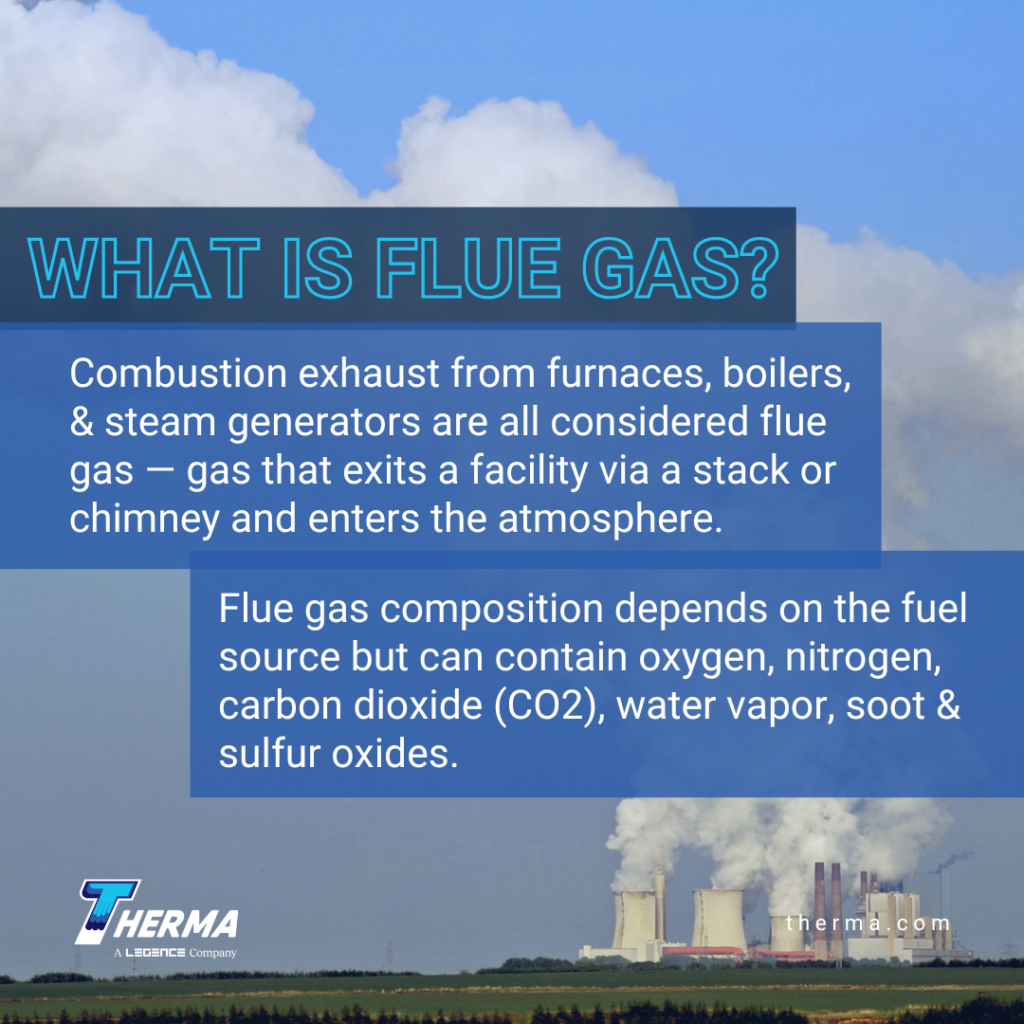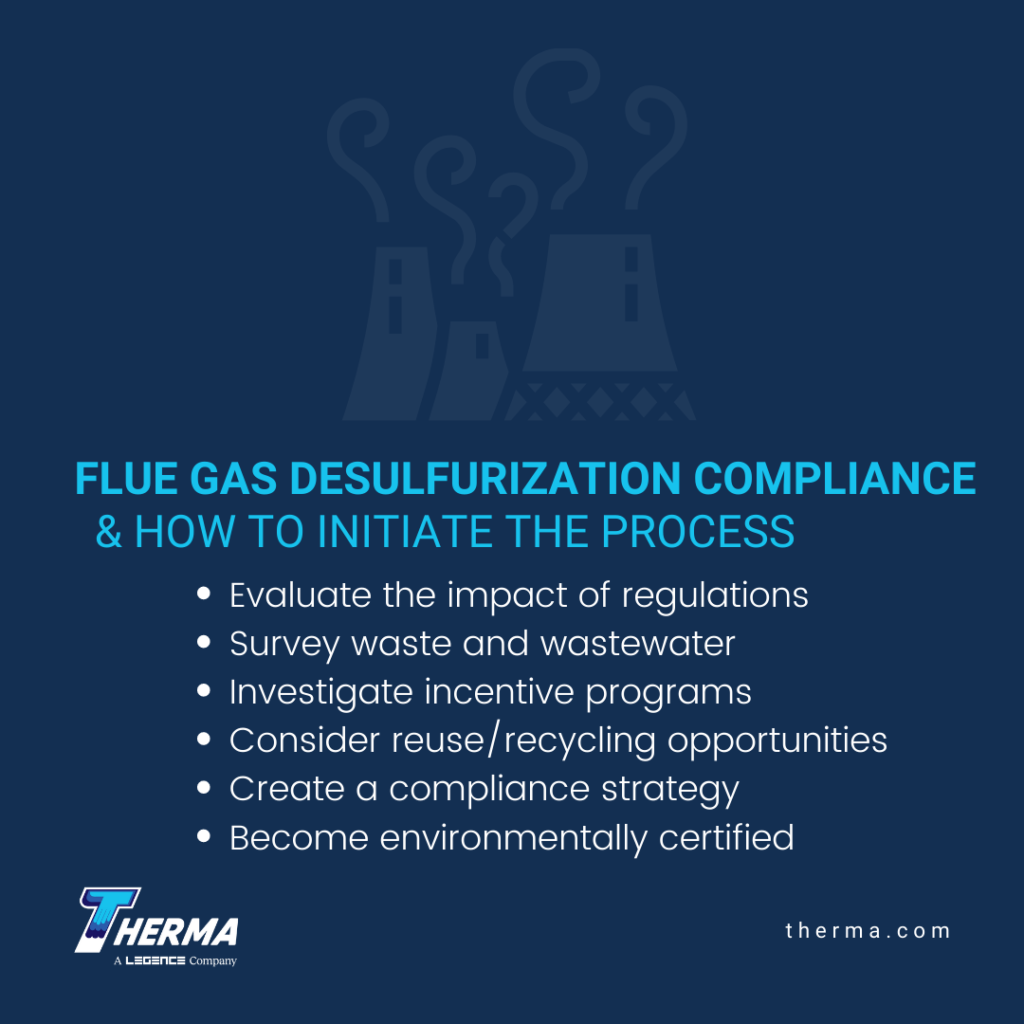by Ali Kriscenski
Environmental regulations for flue gas desulfurization are important considerations to protect air quality, meet compliance standards, and minimize liability. A by-product of industrial combustion flue gas can emit a number of environmental hazards into the atmosphere. As a top-tier source of pollution, flue gas has been the focus of environmental regulations including the Clean Air Act (CAA).
What Is Flue Gas?
Combustion exhaust from furnaces, boilers, and steam generators are all considered flue gas — gas that exits a facility via a stack or chimney and enters the atmosphere. Flue gas composition depends on the fuel source but can contain oxygen, nitrogen, carbon dioxide (CO2), water vapor, soot and sulfur oxides.
According to the U.S. Environmental Protection Agency (EPA):
“sulfur oxides, such as sulfur dioxide (SO2) are highly reactive gasses emitted into the air as a result of fossil fuel combustion and other industrial processes. Short-term exposures to SO2 can harm the human respiratory system and make breathing difficult. People with asthma, particularly children, are sensitive to the effects of SO2.”
SO2 emissions can react with other compounds and form small particles which contribute to pollution that causes health problems, harms fauna and contributes to ecosystem damage through acid rain.

Air Pollution and Human Health
A 2019 study concluded that air pollution is responsible for 6.5 million deaths each year globally. These include emissions containing noxious gasses like carbon dioxide, carbon monoxide, nitrogen oxides (NOx) and sulfur oxides from motor vehicles and industrial operations. Exposure to air pollution can cause inflammation to human cells and lead to chronic conditions such as cardiovascular disease, respiratory diseases, diabetes mellitus, and obesity. It can also increase the risk of reproductive, neurological and immune system disorders, and cancer.
Effects of Air Pollution on the Environment
Air pollution can affect local, regional and global climates. When pollutants enter the atmosphere, they interact with the chemical composition and become part of ecological cycles. As these pollutants combine with clouds and rain they start to enter the hydrological cycle and enter streams, lakes, marshes and oceans. These environments are highly vulnerable to chemical changes and ultimately the pH variances affect fish, wildlife, and plants. Contaminated rain also damages trees as it leaches nutrients and minerals that fauna needs to grow.
Importance of Regulatory Measures
The effects of air pollution on human health and the environment has led to increasingly stringent environmental regulations intended to protect people and nature. The regulations can be global (typically voluntary), federal, regional, or local. While the burden of regulation rests on industry and business, the impact of air pollution affects communities.
 Flue Gas Desulfurization (FGD)
Flue Gas Desulfurization (FGD)
A large focus of air pollution reduction is on flue gas desulfurization to remove sulfur compounds from exhaust emissions. Through the addition of dry or wet absorbents, up to 95% of SO2 can be removed from exhaust emissions. The process can involve adding absorbing circulator pump components to the flue gas emissions that use a steam-saturated absorbent to bond sulfur dioxide. Common methods include flue gas desulfurization systems that can be used in coal or oil-fired combustion facilities including energy/utility production, boilers, waste incinerators, refineries and material production facilities such as lime kilns and metal smelters.
Understanding Effluent Limitations Guidelines (ELG)
One of the key regulations that affect flue gas emissions in the U.S. fall under the Effluent Guidelines. Developed on an industry-by-industry basis, these regulations use technology-based measures for pollution reduction. Because the flue gas desulfurization process essentially binds pollutants through an aqueous process, the elimination of pollutants is controlled (and regulated) through flue gas air pollution control systems, solid waste handling systems and wastewater discharge.
Effective FGD systems for ELG compliance are customized to the industry, scale and related regulations for facilities. In order for facilities to comply, there are a few basic steps that can help initiate the process:
- Evaluate the impact of regulations
- Survey waste and wastewater
- Investigate incentive programs
- Consider reuse/recycling opportunities
- Create a compliance strategy
- Become environmentally certified
Compliance Expertise
Navigating the regulatory landscape of federal regulations for flue gas desulfurization can present challenges to even the most seasoned industry professionals. As current regulations and guidance set forth a compliance timeline until December 31, 2023, the proactive response for implementing effective FGD strategies has become a real-time exercise for facility managers. Enlist the expertise of a technical partner that can provide insight on effective mechanical solutions for FGD compliance. Contact Therma today.
Ali Kriscenski was trained in high-performance building design at Boston Architectural College. She has worked with leading architecture and construction firms in NYC and New England and served on the executive team at the Forest Stewardship Council International. She was the managing editor at Inhabitat and has worked pro bono for the Green Building Institute, ISEAL Alliance and Habitat for Humanity.
Sources
U.S. Environmental Protection Agency (EPA) – Summary of the Clean Air Act
National Institute of Environmental Health Sciences (NIEHS) – Air Pollution and Your Health







